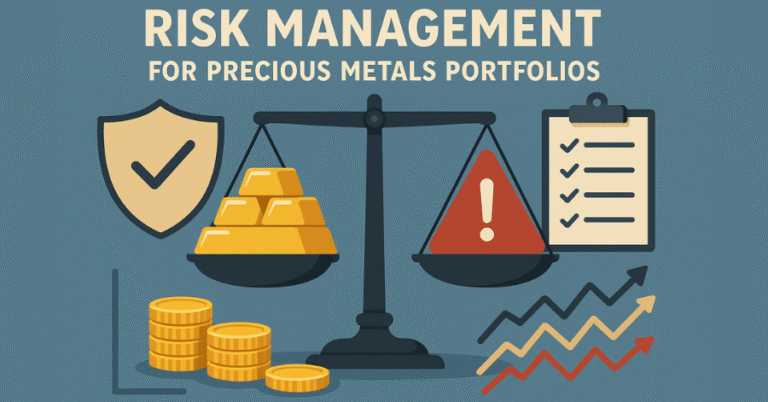Key Takeaways:
- Two main threats to retirement savings: Reduced purchasing power (dollars buy less) and increased market volatility affecting 401(k)s and IRAs
- “Rio Reset” catalyst: References coordinated efforts by BRICS nations to reduce global dollar dependence as a potential trigger for currency decline
- Precious metals as protection: Suggests gold and silver as portfolio diversification tools to hedge against dollar weakness
- Historical precedent: Cites 1970s and 2000s examples when dollar decline coincided with substantial precious metals gains
- Interactive tools included: Features a calculator to demonstrate potential protection scenarios for different dollar decline situations
- Promotional content warning: Contains marketing elements for precious metals investing with emphasis on urgent action needed
Affiliate Disclosure: To support our mission of providing valuable financial analysis, this page may contain affiliate links. If you follow a link and make a purchase, we may earn a commission at no additional cost to you. We only recommend partners we thoroughly research and trust.
Read Our Article: Rio Reset Dollar Shakedown
 Is Gold Your Retirement Shield?
Is Gold Your Retirement Shield?
Introduction:
For decades, Americans have planned their retirements with the U.S. dollar as a steadfast foundation. But what happens when the winds of global finance begin to shift, and the greenback’s long-standing dominance faces new challenges? Understanding the potential dollar decline retirement impact is no longer just an academic exercise; it’s a crucial step for anyone looking to secure their financial future and protect their hard-earned nest egg from the subtle erosion of currency shifts. A weakening dollar can directly affect the value of your savings and what they can actually buy in the future.
Understanding that dollar decline retirement impact is a real concern for modern retirees, let’s examine the most fundamental way this affects your savings.
Dollar Decline Retirement Impact on Purchasing Power
One of the most direct consequences of a dollar decline on retirement impact is the erosion of purchasing power. Simply put, if the dollar loses value relative to other currencies or goods and services, each dollar you’ve saved for retirement will buy less. This is particularly concerning for retirees on fixed incomes or those whose savings are primarily in dollar-denominated assets like U.S. stocks, bonds, and cash. A ‘cheaper’ US dollar could reduce the value of your retirement portfolio, state wealth management advisors.
While reduced purchasing power represents the direct effect of the dollar’s decline. The indirect consequences through market disruption can be equally significant for your retirement accounts.
🛡️ Retirement Portfolio Protection Calculator
Discover how dollar decline could impact your retirement—and how precious metals may protect your future
📊 Your Portfolio Analysis
💰 Impact Analysis
🚨 How Dollar Decline Threatens Your Retirement
Purchasing Power Erosion: A weakening dollar means each retirement dollar buys less. This directly impacts fixed-income retirees whose savings lose value relative to goods and services.
Market Volatility: Currency shifts trigger fluctuations in equity and bond markets, potentially shrinking 401(k)s and IRAs. The Rio Reset signals coordinated global moves away from dollar dependence.
Inflation Acceleration: A declining dollar often leads to imported inflation, further eroding the real value of dollar-denominated retirement assets.
🛡️ Precious Metals: Your Retirement Shield
Historical Store of Value: Gold and silver have preserved wealth for over 5,000 years, maintaining purchasing power through currency crises and economic upheavals.
Dollar Inverse Correlation: Precious metals typically rise when the dollar weakens, providing natural hedge protection for retirement portfolios.
Portfolio Diversification: Financial advisors recommend 5-20% precious metals allocation to reduce overall portfolio risk and volatility.
Tax-Advantaged Options: Precious metals IRAs allow you to hold physical gold and silver within your retirement account structure.
📈 Historical Precedent: When Dollars Declined
1970s Stagflation: Dollar declined 35% while gold rose from $35 to $850 per ounce—a 2,400% increase that protected investors.
2000s Decline: Dollar fell 25% against major currencies while gold tripled from $300 to $1,900 per ounce.
Central Bank Actions: World’s central banks are net buyers of gold, adding 1,000+ tons annually since 2010, signaling institutional awareness of dollar risks.
De-dollarization Trend: BRICS nations and others actively reducing dollar reserves, creating structural headwinds for dollar strength.
🎯 Protect Your Retirement Today
Don’t let dollar decline erode your hard-earned savings. Birch Gold Group, America’s trusted precious metals partner, can help you secure your financial future with IRA-eligible gold and silver.
📚 Educational Resources & Sources
- World Gold Council Research Hub – Official gold market data and analysis
- Federal Reserve Economic Research – Central bank policy impacts
- International Monetary Fund – Global currency system analysis
- Rio Reset Dollar Shakedown Analysis – Understanding the BRICS impact
⚠️ Important Disclaimer
This calculator is for educational purposes only. The calculations provided are simplified models and should not be considered as financial advice or investment recommendations. Past performance does not guarantee future results. Precious metals investments carry risks and may not be suitable for all investors. Please contact a qualified financial advisor to discuss your specific retirement planning needs and investment objectives before making any financial decisions.
Market Volatility and Your Portfolio
A declining dollar can also fuel broader market volatility. As investors react to currency shifts, this can trigger fluctuations in equity and bond markets, potentially shrinking the value of 401(k)s and IRAs. Furthermore, if a weakening dollar reflects deeper economic issues or a loss of confidence, this can create a challenging environment for traditional investments. Some analysts note that the dollar’s longstanding overvaluation might be unwinding, potentially leading to a significant decline against other major currencies.
With both purchasing power erosion and market volatility threatening retirement security, the question becomes: how can retirees shield themselves from dollar decline retirement impact?
Considering Protective Measures
Given the potential dollar decline, savvy savers often explore ways to diversify their holdings. This can include considering assets that have historically acted as a store of value during times of currency weakness or inflation, such as precious metals. The aim is to build a more resilient portfolio that isn’t solely dependent on the fortunes of a single currency.
These protective strategies represent practical responses to dollar decline retirement impact, but successful implementation requires understanding the broader economic landscape shaping our financial future.
Affiliate Disclosure: To support our mission of providing valuable financial analysis, this page may contain affiliate links. If you follow a link and make a purchase, we may earn a commission at no additional cost to you. We only recommend partners we thoroughly research and trust.
Get Ahead Of The Change

If you are ready to take action and secure your retirement, you must act NOW. With the Rio Reset accelerating dollar decline, waiting could cost you everything. Smart retirees are already moving to gold—are you? Get your FREE Info Kit immediately and discover the #1 strategy financial experts use to protect retirement wealth from currency collapse. Limited time offer—claim yours before it’s gone!
Affiliate Disclosure: To support our mission of providing valuable financial analysis, this page may contain affiliate links. If you follow a link and make a purchase, we may earn a commission at no additional cost to you. We only recommend partners we thoroughly research and trust.
Dollar Decline Retirement Impact – Frequently Asked Questions
How can I tell if the dollar is starting to decline significantly?
Key warning signs include the U.S. Dollar Index (DXY) falling below key support levels, central banks diversifying away from dollar reserves, rising import prices despite stable commodity costs, and major trading partners conducting business in alternative currencies. Monitor Federal Reserve policy changes, international trade agreements bypassing the dollar, and precious metals prices rising consistently. The velocity of these changes matters more than isolated incidents.
What percentage of my retirement portfolio should be in precious metals?
Financial advisors typically recommend 5-20% precious metals allocation for retirement portfolios, with most suggesting 10-15% as a starting point. Your specific allocation depends on your risk tolerance, age, and total portfolio size. Younger retirees might lean toward the lower end (5-10%), while those closer to or in retirement often consider 15-20%. Never exceed 25% unless you have extensive experience with precious metals investing.
Are there alternatives to precious metals for protecting against dollar decline?
Yes, several strategies can complement or substitute precious metals: foreign currency ETFs (especially strong currencies like Swiss franc or Singapore dollar), international real estate investment trusts (REITs), foreign government bonds from stable countries, commodity-focused investments, and dividend-paying stocks from companies with significant international revenue. Each has different risk profiles and tax implications.
How does dollar decline affect Social Security and pension payments?
Social Security benefits receive cost-of-living adjustments (COLA) that partially offset inflation, but these adjustments often lag behind actual price increases caused by dollar decline. Traditional pensions typically have no inflation protection, making them vulnerable to purchasing power erosion. Government pensions may have limited COLA provisions. The key concern is that fixed payments become worth less in real terms as the dollar weakens.
Can I hold physical gold and silver in my 401(k) or traditional IRA?
Most employer 401(k) plans don’t allow physical precious metals holdings. However, you can roll over funds to a self-directed IRA that permits IRS-approved precious metals. These must be stored in an approved depository, not at home. Alternatively, many retirement accounts allow precious metals ETFs or mining stocks, though these don’t provide the same direct exposure as physical metals.
What are the tax implications of precious metals in retirement accounts?
Precious metals in traditional IRAs or 401(k)s are taxed as ordinary income when withdrawn, potentially at rates up to 28% for collectibles. Roth IRA precious metals grow tax-free if held for five years and you’re over 59½. Physical metals outside retirement accounts face capital gains tax (0%, 15%, or 20% depending on income) plus the 28% collectibles rate for gains. ETFs typically qualify for standard capital gains treatment.
Should I move my retirement savings to foreign currencies?
Direct foreign currency exposure in retirement accounts is complex and risky due to volatility and limited options. Instead, consider international bond funds, foreign stock funds, or multinational companies with significant overseas revenue. These provide indirect currency exposure with better diversification. Currency-hedged international funds can provide international exposure while reducing currency risk.
How quickly could a major dollar decline happen?
Currency crises can unfold rapidly—typically over months rather than years. The 1970s dollar decline took several years, while more recent currency crises (like the British pound in 2022) happened within weeks. The interconnected global financial system could accelerate any decline. However, the dollar’s reserve currency status provides some stability that smaller currencies lack.
What role does real estate play in protecting against dollar decline?
Real estate can provide some protection as a tangible asset, but effectiveness varies by location and property type. Domestic real estate benefits from dollar decline through potential inflation, but may struggle if economic conditions deteriorate. International real estate or REITs focused on strong-currency countries offer better protection. Real estate’s illiquidity makes it less suitable for quick portfolio adjustments compared to precious metals or ETFs.
How do I monitor my portfolio’s dollar decline exposure?
Review your holdings for dollar-denominated concentration: cash, bonds, domestic stocks, and dollar-based investments represent higher exposure. Calculate the percentage of assets that would benefit from dollar weakness (international stocks, commodities, precious metals). Use online portfolio analysis tools or consult with fee-only financial advisors who can assess your currency risk. Rebalance quarterly or when your target allocations shift by more than 5%.
Is it too late to protect my retirement if dollar decline has already started?
It’s rarely too late to implement protection strategies, though earlier action is generally more effective. Even if decline has begun, currency trends typically unfold over months or years, providing time to adjust. Focus on liquid investments that can be quickly implemented: precious metals ETFs, international funds, or Treasury Inflation-Protected Securities (TIPS). Avoid panic moves—gradual portfolio adjustments often work better than dramatic shifts.
How does inflation differ from dollar decline in terms of retirement impact?
Inflation erodes purchasing power domestically, while dollar decline affects international purchasing power and can accelerate domestic inflation through higher import costs. Dollar decline often triggers inflation, but you can have inflation without significant dollar decline. For retirees, dollar decline is potentially more serious because it affects both domestic prices and the value of dollar-denominated savings relative to global assets. Protection strategies overlap but aren’t identical.
Conclusion
The stability of the U.S. dollar is a cornerstone of many retirement plans, but global economic shifts, like those signaled by the Rio Reset, suggest that proactive awareness of the potential dollar decline retirement impact is essential. Diversification and a keen understanding of how different assets perform in various currency environments can be key to navigating the years ahead. To understand the broader context of these shifts, explore our main guide: Rio Reset Dollar Shakedown: Is Gold Your Retirement’s Unseen Shield?






